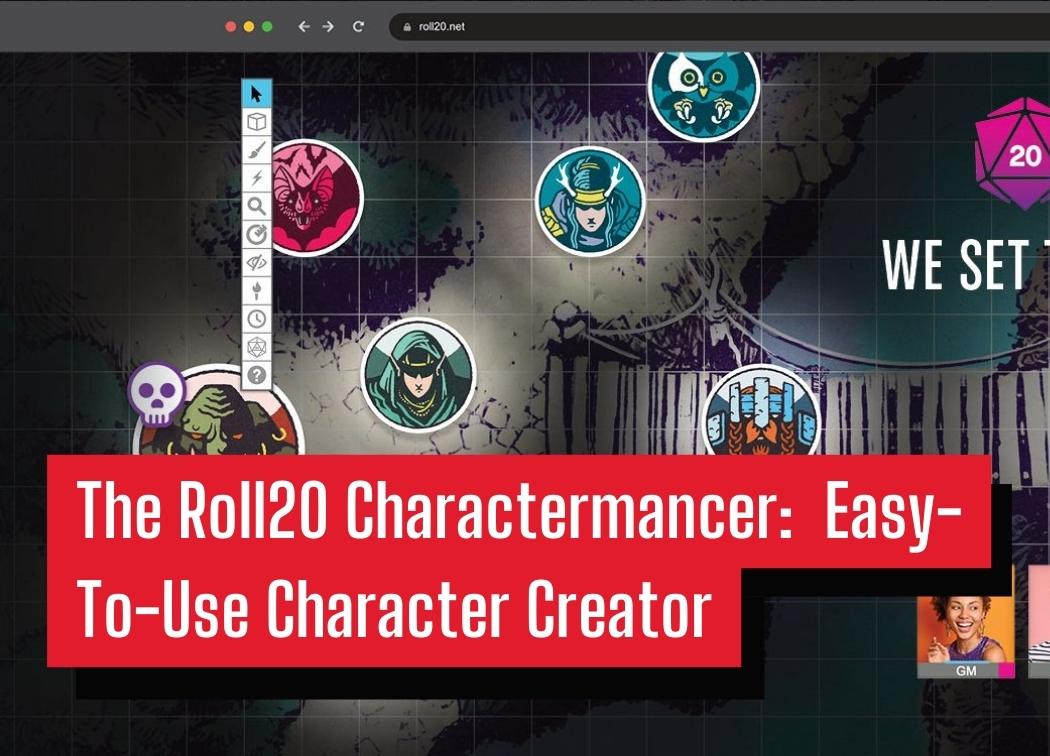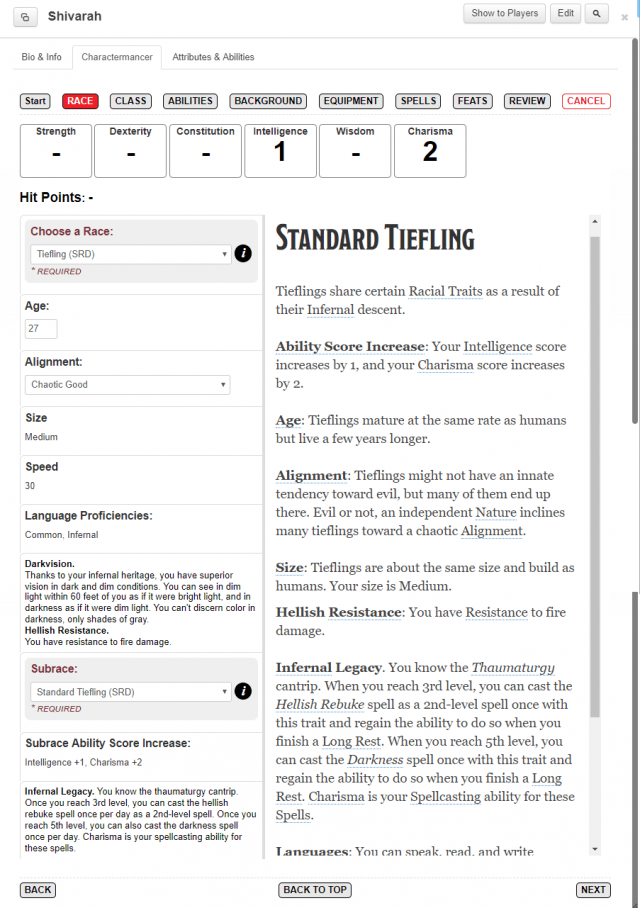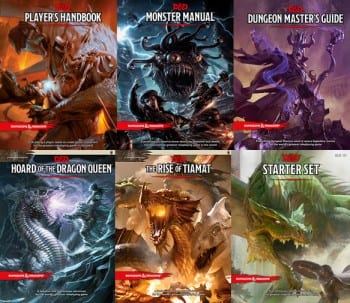The Roll20 Charactermancer: Easy-To-Use Character Creator

Due to some vacations and conflicting work schedules for everyone in my ongoing D&D 5e campaign we’ve had to take some week to 2-week breaks from the game. To combat this we’ve been doing one-shots and trying out different systems so that we are still playing something together each week. This week we opted to go with a D&D 5e one-shot and imagine our surprise when we saw Roll 20’s Charactermancer pop-up when I handed everyone their character sheets.
I wasn’t sure what it was, but I had enabled it out of curiosity. As I’ve mentioned before I’m a huge fan of the extra features that Roll20 has come up with. So, I took a look at it and saw that it’s entirely skippable so I felt that there was no harm in letting everyone try it out. Before the session on Monday, I got some feedback from everyone and it was pretty positive overall.
I’ve since gone back and built my own character using the Charactermancer. Overall I also found it to be a great tool. This post is going to be a run-down of the tool – how to use it and what my thoughts were going through it.
What is the Charactermancer?
The Charactermancer is basically a wizard or setup assistant but for Roll20 D&D 5e characters. The player will click on their character sheet and have the option to go through character creation using the Charactermancer.
The Charactermancer divides the character creation process into sections so only one major decision is made at a time. Race, background, class, etc. are all chosen in separate screens. Relevant rules and information for the player are listed alongside their options in a single screen.
Once the player has gone through the entire Charactermancer process (or as much as they desire to go through) they’ll save their sheet and it will be automatically filled in by the Charactermancer.
D&D 5e SRD & Player’s Handbook Only
As of right now, only the SRD is made available to everyone. If you want you can purchase the Player’s Handbook on Roll20 and can use that in the Charactermancer as well. GMs that have the PHB on Roll20 are able to share their compendiums with 3-5 groups depending on their subscription.
Unfortunately, I don’t buy my books through Roll20 since I prefer the physical copies so we were stuck with the SRD. Thankfully everything was pretty customizable and is able to be changed after the sheet is created.
They have mentioned in a blog post that they are working on using the Charactermancer for other systems. However, D&D 5e’s SRD and PHB can be used at this time.
As of 9/25/18 Pathfinder has its own Charactermancer!
Using the Charactermancer
Before You Begin
The Start Menu gives you a quick run-down of what the Charactermancer is. From here you can hit either the Next button to bring you to the Race Menu, or you can manually select any of the character creation menus. You can make your character in whatever order you please and you can leave menus completely blank if you choose.
If this doesn’t seem like something you want to use just hit the OPT OUT button. You’ll be taken directly to a blank character sheet and you can manually fill it in.
Race

The first menu is the Race Menu. In here you’ll select your race from the drop-down list along with any Subrace for applicable races. If you don’t have the PHB on Roll20 you’ll only be able to select from SRD races which is only a single subrace per race.
Don’t worry about this though, you can fill in a custom race and/or subrace as well! If you’re like me and my group and own the physical books you can simply type everything in here and the Charactermancer will take the mechanical bonuses into consideration for the rest of the process.
Once you select a race you’ll be able to see its +2 and +1 bonuses in the ability scores bar at the top of the window. This will be useful in the Abilities Menu to help you choose where to allocate your rolls or stat points.
Class
The next menu is the Class Menu. For most classes, you’ll only have to choose the class and your skill proficiencies. Any classes that get their archetype at level 1 will have to choose that as well in here.
As you may have noticed the SRD or PHB is open to the relevant sections in each menu. This is an awesome feature for new players or existing players playing a new race, class, etc. It will update alongside your class choice so you can look through it if you’re trying to make a decision between two or more classes.
The Charactermancer also will now show your class’ spellcasting ability throughout the remainder of the menus. This is particularly helpful for allocating your ability scores in the next section.
Ability Scores
You’ll only have one option in the Ability Score Method drop-down menu in the Abilities Menu and that is “Custom”. It seems like it will be worked on in the future, but as of right now it’s no different from manually inputting your ability scores in a character sheet.
For the rest of the character creation process, your ability scores will be filled-in in the bar at the top.
As I’ve mentioned before my group has been keen on using Point Buy so I used that method. You can learn all about it in this post.
Background
The Background Menu has a lot of choices for you to make depending on the background. Choose languages, personality traits, an ideal, a bond, and a flaw. The traits can be either selected from the drop-down menu or rolled on and selected at random. Unfortunately, you cannot fill in your own option for these choices.
You’ll also be able to see what the background feature is as well as the extra equipment you’ll receive when choosing this background.
If you’re using the SRD you’ll only have the option of taking the Acolyte background or filling in your own.
Equipment
Depending on the class you selected you will have a choice of multiple types of weapons and (maybe) armor. You’ll also have to choose between 2 separate packs of items. Some backgrounds may also have equipment choices for you to make. All of this will be done here.
This is one of my favorite features of the Charactermancer as it takes away all of the book-keeping. It will add these items to your inventory and calculate all of their weights, quantities, and descriptions. The weapons and armor will also be added to their appropriate sections of the sheet and any macros involving them will be made for you. It’s an excellent feature.
Spells
In the Spells Menu, you can choose whatever Cantrips and Level 1 spells your class starts with. This changes depending on what class you’ve selected so it was nice to have everything listed for me.
You’ll also notice that it shows my tiefling’s racial bonus Cantrip, Thaumaturgy, on this menu. This was a nice feature as it would remind me not to double-up on that Cantrip.
I’ve found that new players typically shy away from creating magic users as they’re much more complicated to create and understand. This really streamlined the process and helped show what your character can and cannot do. It’s both a convenience and a learning tool that helps all types of players with creating a magic user.
Feats
This menu is pretty straight-forward. Unfortunately, since I can only use the SRD and therefore, don’t have access to the Variant Human race I’d never need this menu.
That being said this is still a good option to help condense the many feats from many different sourcebooks into one as more are supported by the Charactermancer in the future. However, I wouldn’t be opposed to just putting this in the Abilities Menu as you would be doing both at the same time when determining your Ability Score Increase. There’s no need for two menus to do the same job in my opinion.
Review
Check everything over before you hit the Apply Changes button here. Everything can still be changed after you finished either manually or by starting the Charactermancer again.
You can see that when I switched Shivarah to a wizard for the Spells Menu screenshot I forgot to redo my equipment selection. The red text there reminded me of this and I was able to go back and choose all my equipment again without closing the menu.
The Finished Sheet
Once you’ve hit the “Apply Changes” button in the Review Menu your sheet will look like any other filled-out character sheet in Roll20. All you need to do now is enter all of the BIO information you need for your character. The rest has been done for you already!
If there was something you’d like to change post-Charactermacner character creation you have two options. You can either edit it yourself in the sheet, or you can click on the settings wheel and restart the Charactermancer. Don’t worry, your progress will be saved and you won’t have to do everything all over again.
Thoughts and Criticisms
The Good
Highlighting Choices You’ve Already Made
When I was choosing skills and languages in the Class and Background menus I noticed that ones that I had previously picked are highlighted for me. This was an excellent quality of life feature as it saved me from switching between menus to ensure I wasn’t double-dipping.
It’s small and something that I would not have thought of, but it’s a great feature. It ensures that the player is going to stay on the menu. This means that the process will be streamlined and there’s no need to backtrack.
The Book Keeping is Done For You
I can’t stress this enough. Having my weapons, armor, and inventory added in and set-up correctly was such an enormous benefit. As an experienced player, this is an annoyance for me at this point. Calculating item weights, creating all my weapon macros, and enabling my pieces of armor is tedious.
This is typically the area that I see first-time Roll20 users or D&D players have issues. Having Roll20 do it for you allows them to focus on learning the game rather than book-keeping.
This goes for spells as well, but that’s been a feature since they released the Compendium so I didn’t think as much of it. Regardless, it’s another great feature of the Charactermancer and Roll20 in general.
Everything You Need is There
Having the relevant rules and extra information like your Class’ Spellcasting Ability is excellent for new players. These are things that they will need when they are creating a character the first time. This information is useful for more experienced players playing a new class as well.
The best part is that it doesn’t even take up much space. Players that don’t need this information can simply focus on the left-hand side of the window.
I really like the Charactermancer’s UI design in general. I think it was well-designed and kept both new and experienced players in mind every step of the way.
Criticisms
The Abilities Menu
Having to manually input my character’s ability scores was sort-of expected for me. I did not assume that Point Buy would be a normal option despite it being an official option in the PHB.
I was surprised that there was no option to roll for ability scores in the Charactermancer. Initially, I assumed that you would be unable to roll within the Charactermancer at all. However, once I saw that you could roll for Personality Traits (and more) in the Background section I felt pretty disappointed in the Abilities menu.
Ideally, the standard 4d6 keep 3, the standard set, and point buy ability score options should all be available to use within the Charactermancer.
The Feats Menu Seems Unnecessary
As it is right now it’s only going to be used for variant human characters (or a homebrew race) if you own the PHB. Otherwise, it’s simply one more menu to click through. I think it would be a better idea to have this in the Ability Scores menu. That way it will be consistent with the choice of ASI or Feat when the Charactermancer is updated to be used for level ups in the future.
This is a minor nitpick at best though as it’s easy enough to skip past.
Name, Weight, Height and Other Descriptors
These were missing from the wizard completely. They’re easy enough to write-up after the character has been created, but I feel like the spirit of the Charactermancer is that once you hit the Finish button you have a fully built character.
This isn’t the case if these are still required and it’s easy enough to add some text boxes in the Race or Background section to accommodate these descriptors.
Custom Options for Personality Traits, Ideal, Bond, and Flaw
I was surprised that there was no “custom” option for those in the Background section. While it can be changed after the Charactermancer builds the character it is a bit odd that this was the only section where “custom” was completely missing from these drop-down menus.
Planned Updates

More Sourcebooks
In the blog post, they mentioned that more sourcebooks will be added to the Charactermancer in the future. This is expected, but it’s always appreciated to hear a confirmation.
While personally I still prefer the physical copies this does make me think twice about grabbing the books on Roll20 in the future if the price was right. The ability to now share your compendium with your group is huge and the Charactermancer is just the icing on the cake.
Level Up
The Charactermancer can now be used for level-ups for D&D 5e characters as of 1/8/2019. This update makes character management considerably more manageable for classes that have a lot of additional features to go through. Currently, you can only use the free SRD or the PHB and Guildmasters’ Guide to Ravnica with the Charactermancer.
For example, Clerics and other magic users that prepare their spells will have a lot more bookkeeping to do every couple of levels compared to most martial characters. This new feature will be particularly welcomed by them but will save everyone quite a bit of time copying-over their spells and features.
Conclusions
This is still an excellent tool even if you have to manually enter homebrew or info outside of the realm of the SRD and/or PHB. Recording things like your items, basic weapons, and other tedious book-keeping is done with a click of a button. For that alone, I feel as though it’s worth always using the Charactermancer as it’s by far one of my least favorite parts about making a character.
I also love that the relevant rules for each part of the character creation process are listed alongside the options the player has to choose from. This is especially helpful for new players, but it is still easily ignored by more experienced players.
Roll20 has done a great job at making it both intuitive and useful for new players and a great tool to streamline the tedious parts for experienced players. I’m excited to see how the Charactermancer evolves for D&D 5e and in other systems as it is an excellent tool.
